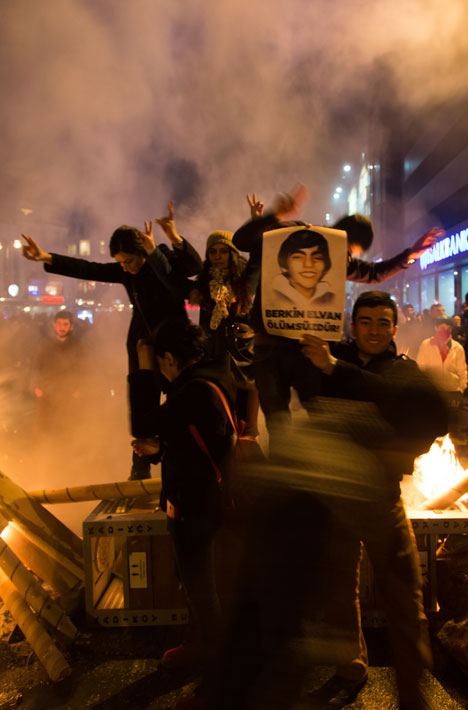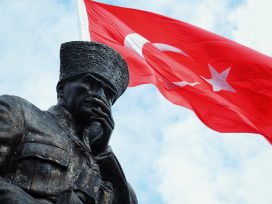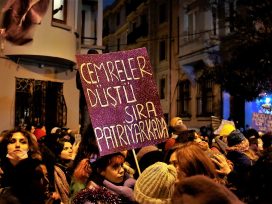In spring 2011, when Tunisia, Egypt, Spain and Greece were in the throes of mass public dissent, some of us sarcastically joked that Turkey would be next. We were convinced it could not happen and discussed how and why the Turkish situation was different. I remember posting a status update on Facebook explaining how the Arab Spring was tangential to Turkish concerns – echoing the prime minister’s comment that the 2008 economic crisis was tangential to the Turkish economy. I was then living in London, and being away from Turkey for almost a decade had made me overlook some of the dynamics in play.

The funeral of Berkin Elvan took place on 12 March 2014 in Istanbul, with the participation of hundreds of thousands of people. Meanwhile thousands took to the streets in cities across Turkey. Many interpreted these large numbers of people on the streets as the reawakening of the Gezi Spirit. Photo: Evren Kalinbacak/Shutterstock. Source: Shutterstock
After I moved back to Istanbul it took less than a year for my certainties to be shattered. One of the most important uprisings in Turkish memory had broken out by the end of spring 2013, and the months between then and the summer turned out to be a historic period for political activism in Turkey. Commonly referred to as the Gezi Resistance, the grassroots mobilization caught the AKP government offguard, as hundreds of thousands of people rushed to the streets, squares and parks to reclaim those spaces. It has been a year now since the resistance started, and it has changed the scope of possibility for activism in Turkey.
This article looks back at a year of unrest – at its expressions in grassroots mobilization and its interaction with formal political processes. Starting with an overview of the triggers of the unrest, it will go on to explore some of the new political formations that have come into being, such as park forums, participatory forms of electoral monitoring and, perhaps most interestingly, the emergence of #occupyCHP, a movement to bring the spirit of horizontal activism into one of the mainstream Turkish political parties. Although the story of the Gezi Park occupation and the evolution of the resistance has been explored in both the academy and more popular press, a brief summary of what has happened may be useful here.
The occupation begins
The catalyst which triggered the events was an attempt by a handful of environmentalists to protect a few trees from being cut down. At the end of May 2013, the government decided to raze Gezi Park and the trees within it, in order to build a replica of an old Ottoman barracks that would contain a shopping mall and a mosque, and in response an unexpected crowd gathered to protest the demolition. The protestors, an unusual assortment of people for such events, and representing a broad section of Istanbul society, somehow managed to pass the usual thresholds of fear when confronted by authorities, and instead of running away and leaving the streets fought back against the police, who attacked them with tear gas and water cannons. The resistance to the police and their excessive violence sparked a chain reaction, and, as word spread, more people left their homes and joined the street protests. Moreover, although the mainstream media ignored this large-scale public unrest, they could not stop information getting out: surveys have confirmed that information about the resistance spread out via social media, and that the profile of the protesters was quite young, following trends established in other countries.
Gezi Park is in the centre of Istanbul and is one of the very few green areas that is freely accessible to the city’s inhabitants. What we saw at the end of spring 2013 was a popular movement to reclaim the park as a public space. As well as rejecting neoliberal gentrification projects, protestors were reacting to the “authoritarian reflexes of the AKP government and the police brutality it inflicted on the people” – it was this that made the struggle for Gezi Park “jump scales from the urban to the national”. However determined the activists were to protect the park against demolition, it was hard for them to maintain direct action against the onslaught of the police. Police attacked with tear gas bombs and water cannons, and in the early hours of 30 May set the tents of activists on fire. But it was this attack that, having forced the activists out of the park, created the opportunity for them to gather with others and start a fiercer protest around Taksim Square.
Instead of repressing the resistance, the escalation of police brutality increased the number of people participating in it, and this led to a unique resistance movement that spread across the country. The spirit of protest quickly moved beyond the local demand represented in the strong will of those protecting the park from demolition, and became a nationwide chain of protests involving a wide variety of grievances against the AKP government. What we call the Gezi resistance thus refers to a larger scale collective reaction – not only to existing and ongoing urban remodelling projects but also to the mounting political authoritarianism that affects daily life in Turkey.
I believe that it was the simmering grievances that already existed amongst Turkish citizens that paved the way for the spontaneous formation of a fullyfledged resistance movement. Recent causes of unrest, attracting limited but widely supported protests, have included the bombing of civilians in Roboski in December 2011; bomb attacks in the border town of Reyhanli in April 2013; the media blackout during these two events; the provocative patriarchal speeches of the prime minister and the restrictions that have been imposed on women’s reproductive rights; the clampdown on 1 May demonstrations; the restrictions on the sale of alcohol; and the neoliberal “urban transformation” projects, such as the project for the third bridge across the Bosporus, named for Sultan Selim, famous for his massacre of Alevis. The Gezi resistance seems to be the result of the accumulation of all those collective grievances, through the drive to reclaim Gezi Park and adjoining Taksim Square as a public space.
Mirroring other “take the squares” movements across the Mediterranean and beyond, Taksim/Gezi Park became the paradigmatic public space both physically and symbolically, as reflected in the most popular chant: “Everywhere is Taksim, resistance everywhere”. This slogan became even more meaningful with the mushrooming of local park forums following the police evacuation of the park on 15 June: after the eviction the resistance took the chance to establish itself in different areas in the form of local park forums.
Significantly, the Gezi Resistance was able to mobilize multiple identity groups as they entered the political arena. One of the features that makes the resistance interesting is the way in which a focus on solidarity was maintained among crowds that had gathered spontaneously, despite conflicting ideological positions and different social positions. The two-week long occupation of Gezi Park and Taksim Square converted this recreational area into a radical democratic public sphere. Testimony from the time records astonishment among some protesters at moments when they encountered the “other” and were not disturbed by this. Powerful examples of such moments from the occupation include Kurdish groups holding Kurdish flags with calan’s photo in collaboration with Turkish nationalists holding Turkish flags with Ataturk’s photo, or football fans reputed to be homophobic and sexist standing on the barricades next to LGBTIs.
These sorts of encounters were maintained during the local park forums, where individuals took turns to speak on an open microphone and shared their reflections. What we saw at Gezi Park and at the local park forums was exceptional in Turkey: urban citizens were reclaiming the commons for radical democratic formations while in the process of establishing agonistic relations. These occasions are interesting indicators of a potential radical democratic trajectory: public spaces, in being utilized as forums and public assemblies, offer the potential for creating a space for solidarity that is negotiated around local issues despite ideological, class and other differences.
These are public spaces where citizens can realize the power of debate and negotiation outside the limited discourses of institutionalized politics. Radical democracy can be seen as an ongoing process of articulations and dislocations within any given hegemonic struggle; it is not a matter of people establishing a “mere alliance between given interests”, but rather of “actually modifying their identity so as to bring about a new political identity”. And we believe that what the protesters named as the Gezi Spirit was a seed of this process. This was borne out by the number of occasions when we witnessed the eagerness and enthusiasm of different groups of people showing solidarity with others. For example, a record number of people participated in the Gay Pride Parade in Istanbul on 30 June 2013, and the chants were very much related to resistances in other cities. The names of individuals being killed as a result of police brutality were shouted by a hundred-thousand- strong crowd under a rainbow flag. This was followed later in the summer during Ramadan by street dining organized by Anticapitalist Muslims, which was attended by many Muslims, non-Muslims, atheists, LGBTIs etc. Chanting during these dinners rehearsed calls for resistance from the Gay Pride Parade.
Even the fans of three rival football teams in Istanbul (Fenerbahce, Galatasaray and Besiktas) set the example of solidarity as they named themselves “Istanbul United”. A tradition has grown up of chanting “everywhere is Taksim, resistance everywhere” during the football games of these teams, especially at the 34th minute of each game (34 is the plate number for Istanbul).
Winter developments
By the end of autumn 2013 the protests had started to change form. Many of the park forums were dissolved because of the coming winter and the inconvenience of cold public spaces for long hours of meetings. That was the obvious reason. But I also think the March 2014 local elections, with the shift of focus they brought onto political parties, played a destructive role for the post-Gezi politicization.
Initially Gezi activists declared the need to seek alternative ways of doing politics, which were to be more inclusive, direct and local. Instead of the reductionist binary discourse of either A or B, the Gezi spirit was about hearing and negotiating with the “other”. However, the election process hijacked this spirit. Radical democratic negotiations were put on hold, as elections forced activists to focus on following party lines, and narrowed down the emergent subjectivities and discourses to identification with party logos. The path of non-discriminatory, inclusive discussions was abandoned for the sake of supporting one or other of the opposition parties against the AKP. The traditional organized and centralized, top-down, way of doing politics trapped the horizontalist approach of the new politics before it could ripen to offer alternatives.
On the other hand, the election campaign period seem to provide a certain level of comfort and relief to the people of Turkey, including the Gezi protesters. The process of creating alternatives to the existing and entrenched system is a longerterm effort than anything that can be achieved in a single election, but there was the illusion of challenging the authoritarianism of the AKP by campaigning and voting. Many seem to take the bait offered by the parties in the run-up to polling day, and although some were not convinced, most Gezi activists left the sphere of politics to politicians of the status quo.
In the end standing aside was virtually impossible, given the vicissitudes of Turkish politics. On 17 December the first of a series of sound recordings was released via social media. These recordings allegedly presented cabinet members, their sons and a number of businessmen in conversations regarding high-level corruption and misconduct. The recordings also included conversations between the prime minister and journalists that raised serious questions about journalistic ethics and the impartiality of mainstream media. Between 17 December and 30 March (the day of the elections) many citizens followed these recordings with great interest as they were released day after day, with similar but new stories of fraud. These recordings loomed large in the popular imaginary.
But the activist spirit was ultimately reawakened in tragic circumstances, through the death of Berkin Elvan, a fifteen-year-old boy and one of the most significant figures of the Gezi resistance. When Berkin died after 265 days in a coma brought on by being hit on his head by a tear gas canister, there was a widespread emotional response: thousands of people gathered in front of the hospital on the day he died. The young boy and his fight for survival in hospital had been regarded as a symbol of ongoing resistance. The hash tags #direnberkin and #resistberkin had been used by many to support his family, who had themselves tweeted regularly to inform the public about his health, as well as the proceedings of their court battle to find the riot officers responsible.
The funeral of Berkin Elvan took place on 12 March 2014 in Istanbul, with the participation of hundreds of thousands of people. Meanwhile thousands took to the streets in cities across Turkey. Many interpreted these large numbers of people on the streets as the reawakening of the Gezi Spirit.
But the peaceful funeral march was ended by extreme police violence. The riot police attacked without giving a proper warning. Twenty people were reported as being injured, and a heavy police presence remained in place on the streets until the following morning. The situation was made worse when prime minister Erdogan claimed during a campaign rally that Berkin Elvan was a terrorist, and that is why he had been shot. Erdogan then went on to blame the boy’s mother for agitation and inflaming the public.
To make matters even worse, on the night of the funeral a 22-year-old man, Burak Can Karamanoglu, was killed in the neighbourhood where the Elvan family lived. But whereas Berkin Elvan had been close to radical left groups, Burak Can Karamanoglu was associated with ultranationalist groups. Suddenly there was a threat of armed street fights between these groups, of a kind that had paved the way for coup d’tats in previous Turkish history. However, despite provocations, the families of Berkin and Burak, as well as the general public, remained calm, and no further clashes occurred. Despite historical differences and controversies, feelings of solidarity and empathy outweighed the incentives for violence.
A week later, Twitter was banned in Turkey. Erdogan announced his detestation of social media on 20 March, again at a campaign rally. The following day Twitter was not available without tricks like VPNs and IP routing – something many Turkish citizens had already mastered because of previous bans of YouTube and other websites.
Interestingly enough, the rest of the world was informed about the Twitter ban via the popular hash tag #TurkeybannedTwitter, tweeted by millions of users in Turkey, which became a trending topic worldwide. After a few days, the government also banned access to YouTube. It is important to note here that Twitter and YouTube had been the main tools for disseminating the recordings that had exposed alleged political corruption. What is most striking, though, was the public consensus to stay calm rather than go out on the streets to protest. There were many Facebook and Twitter messages arguing that we (the opposition of all kinds but especially the Gezi activists) should remain calm and stay at home until the elections were over, in order not to put at risk a secure environment for fair elections. This was perhaps another example of formal, electoral politics hijacking and subduing the street mobilizations.
The majority of people who joined the Gezi Protests seemed to believe that street protests would harm the local elections, and that people would use their votes to demonstrate dissent. Indeed, this view was very similar to the discourse of Erdogan and government spokespeople, who repeatedly emphasized the ballot box as the place where tensions should be resolved. They argued, in a rather intimidating way, that “the will of nation” could only be seen via election results. Of course this overemphasis on the elections could easily be read as the imposing the tyranny of the majority. But citizens of Turkey seemed to appreciate the elections as a means of democracy and consented to stay off the streets until the end of March.
One response to this line of thinking was a civil initiative called Oy ve Ötesi (“Vote and beyond”), established by volunteers a few months prior to the elections. The group came together on a regular basis in local centres in Istanbul in order to plan how to prevent fraud during the elections as well as counting the votes. For this reason a volunteer was assigned for each ballot box along with the representative of the political parties, who could act as an independent observer and report any case of fraud.
The local elections and their aftermath
During the night of the election, when the votes were being counted, there were several controversial instances of blackouts, especially in cities where the race between AKP-CHP or AKP-BDP was tight. Two days after the elections the energy minister announced, somewhat unconvincingly, that it must have been cats climbing into electrical transformers that had caused the power cuts. In a number of constituencies the counts and recounts continued for the next four days. Overall, a significant number of cases of fraud were reported, and citizens took the initiative of staying over night at the schools where the polls were contested, to help oversee the recounts. They also developed a system of keeping each other informed via social media, using photographed evidence as a way of checking figures entered into the official database system.
Ankara, the capital of Turkey, was a main focus in terms of election fraud, and an interesting new initiative arose in response: #OccupyCHP. There was a very tight mayoral contest in the city between the AKP’s Melih Gkek (Mayor since 1994) and the CHP’s Mansur Yavas. Both parties claimed to have won the elections on the election night. The AKP claimed to be leading by a small margin, but the CHP placed their faith in the accuracy of hundreds of ballot counts in the neighbourhoods where they traditionally receive most votes. However, when people woke up the next morning, the official difference between the parties was quite significant: apparently the AKP had received many more votes than expected from traditional CHP neighbourhoods. In response, thousands of citizens brought their personal laptops and met at CHP centres in Ankara. Over the next two days they recounted the votes, and retrieved the official election reports that had been used to support the numbers. Meanwhile, thousands of others waited in front of the Higher Election Commission head office in Ankara – where they were once again subject to police violence.
However, the Higher Election Commission rejected the CHP’s application requesting an official recount and consideration of the evidence from citizen activists, and this event became the trigger for the #OccupyCHP initiative, launched by a group of young citizens who had become frustrated at the ineffectiveness of the CHP opposition. This new idea – of occupying CHP, a 90-year-old political party, and the main opposition to the AKP government since 2002 – is rapidly growing. At the time of writing, the group was collectively drafting a manifesto that opens with the statement that: “#OccupyCHP aims at governance in the Gezi Spirit: free thought, free consciousness and free conscience within the CHP”. Time will tell if #OccupyCHP will become an organized opposition within and beyond CHP, yet it clearly is a further outcome of the Gezi Resistance. Civil initiatives such as #OccupyCHP, Oy ve tesi and others are particularly significant as they seem to reflect a desire by younger generations to engage with politics. Instead of remaining apathetic in face of an outdated political system that excludes them, they are actively intervening to modify it.
In my view, therefore, there is evidence that the Gezi spirit is still alive, even though there is not much left of the park forums. Despite the short life-span of the occupation itself, the Gezi resistance had a great and irreversible impact on citizens of Turkey. There are now a number of other forms of solidarity, and a greater awareness of the power of individuals. Since May 2013 there have been many more reasons to protest against the government – including their internet censorship and the recordings scandal – and we have witnessed a series of demonstrations and clashes with the riot police. There have been injuries – and even deaths – and in Istanbul in particular we seem to have become inured to the constant presence on the streets of riot police and militarized vehicles for crowd control. We have not seen a revolution, as in Egypt. On the other hand, the Gezi resistance has changed the political language of the nation, brought a new form of consciousness into the politics of everyday life, and opened people’s eyes to the possibilities of resistance. The political culture of Turkish citizens is nevertheless still very much dominated by a normative representative system – in spite of its flaws in Turkey, where there is a 10 per cent electoral threshold for parliamentary seats, and constant allegations of systemic corruption. Thus the electoral campaign leading up to the March 2014 local elections constrained the possibilities for the kinds of political debate and engagement that the Gezi resistance aspired to. Although some considered the elections to be an opportunity to teach the AKP government a lesson, in my view the elections were more a trap than an opportunity: they squashed the newly blossoming politicisation – including a novel language of solidarity and the grassroots mobilisation of new generations – and forced it back into the discourse of party-managed politics.
Elections in representative systems tend to reduce complex and nuanced discussion and debate into populist slogans. The activists of Gezi resistance had started to build the language of solidarity despite conflicts of interest and ideology – they had started to do politics with a different logic. But as the elections took centre stage in the political arena, this had to be translated into a more traditional political language, which did not correspond to the emerging local, direct, participatory democratic forums. In the end what we saw was a mainstream political party – the CHP – becoming the only choice against the AKP, and this marginalized and neutralized the radical democratic claims of the Gezi movement. Turkish citizens have been long familiar with this polarized politics; the same emphasis on “no other choice” has dominated electoral choices for decades – and this in part explains the value of the perhaps sometimes over-romanticized Gezi spirit, which was seen as a remedy to the seemingly unending cycle of political polarization. The results of local elections revealed one thing that should have already been crystal clear: the current representative political system does not meet the requirements of contemporary political demands. When there is a single “no” and multiple “yeses”, a system of election that limits voters’ choice to second best is not meeting aspirations for a multifarious, radical democratic process.
On the other hand, in a radical democratic perspective, citizenship does not refer simply to the individual’s relationship to the state and institutions but moves beyond to other sites of politics. The occupation of Gezi Park in Istanbul should therefore be seen as an opportunity for radical democratic emancipation. In this context emancipation refers to the possibilities opened up for contesting the dominating discourses of a majoritarian neoconservative government. Public space becomes an agonistic domain that enables individuals to appear – to become visible; and hence it offers the possibility of interaction and acknowledgement, and of joining collaborative struggles against dominant discourses. Dissent requires a public space, and Gezi Park became this public space in Turkey, both physically and symbolically.







